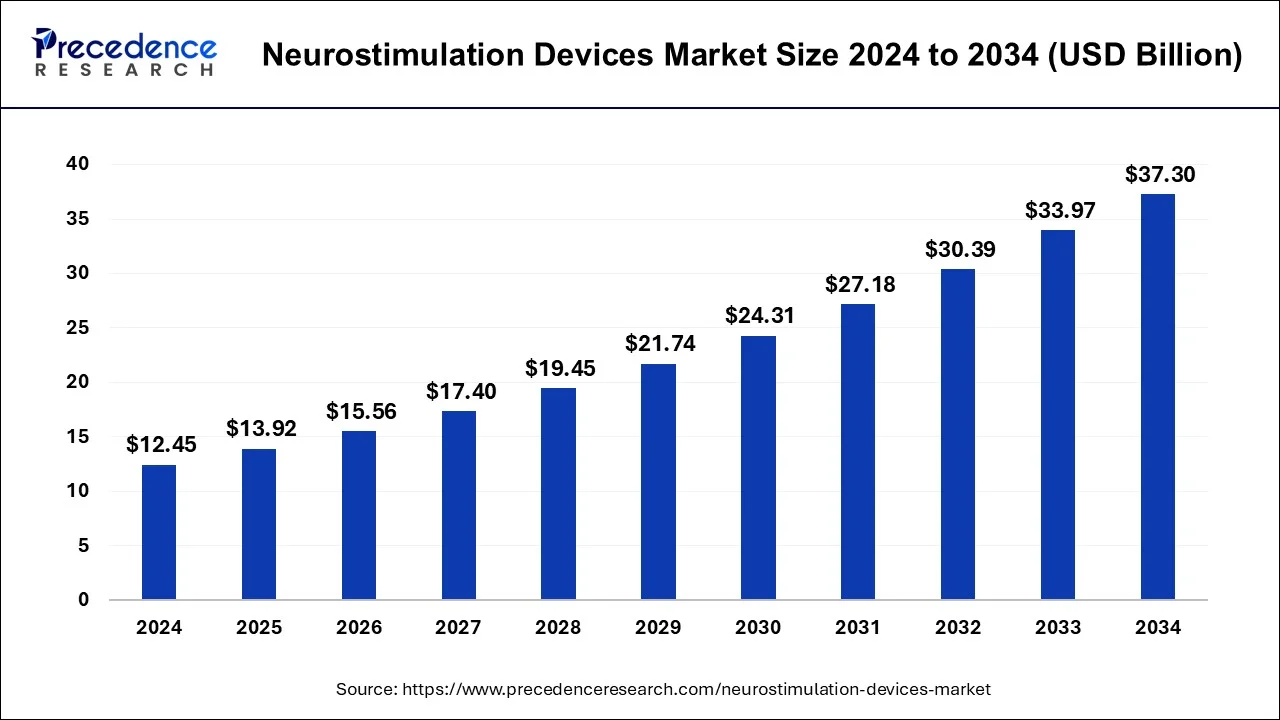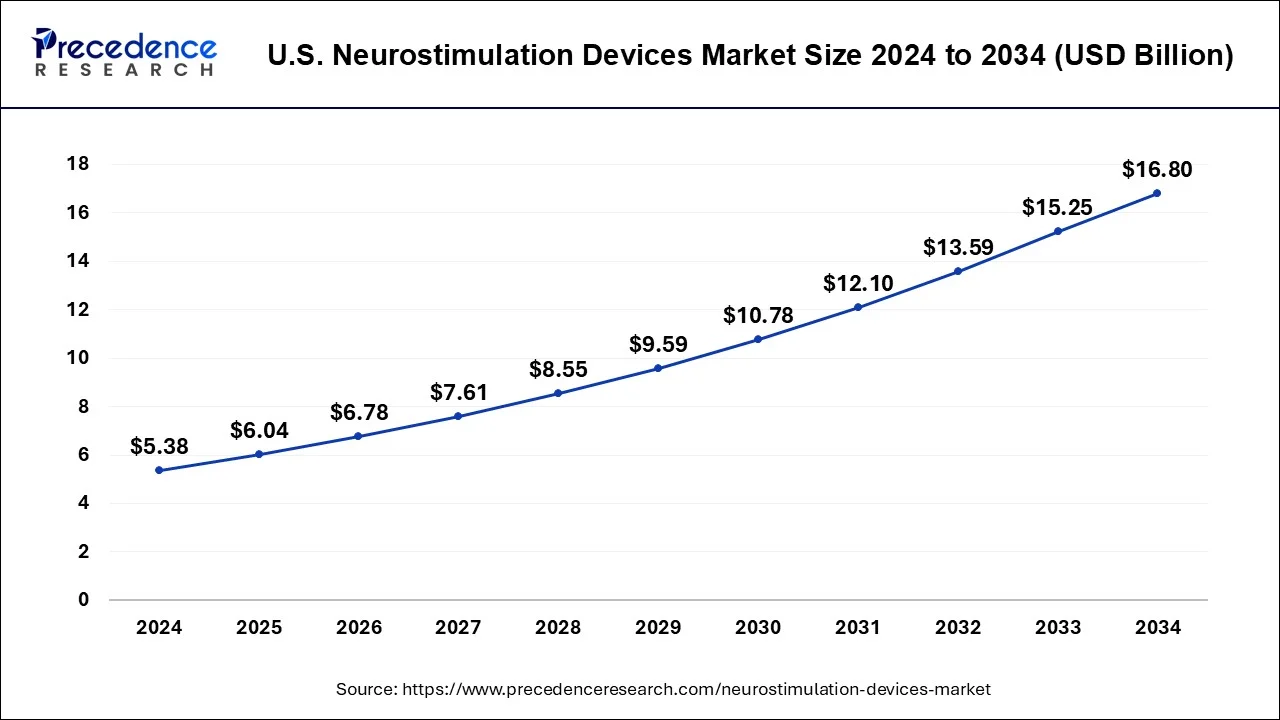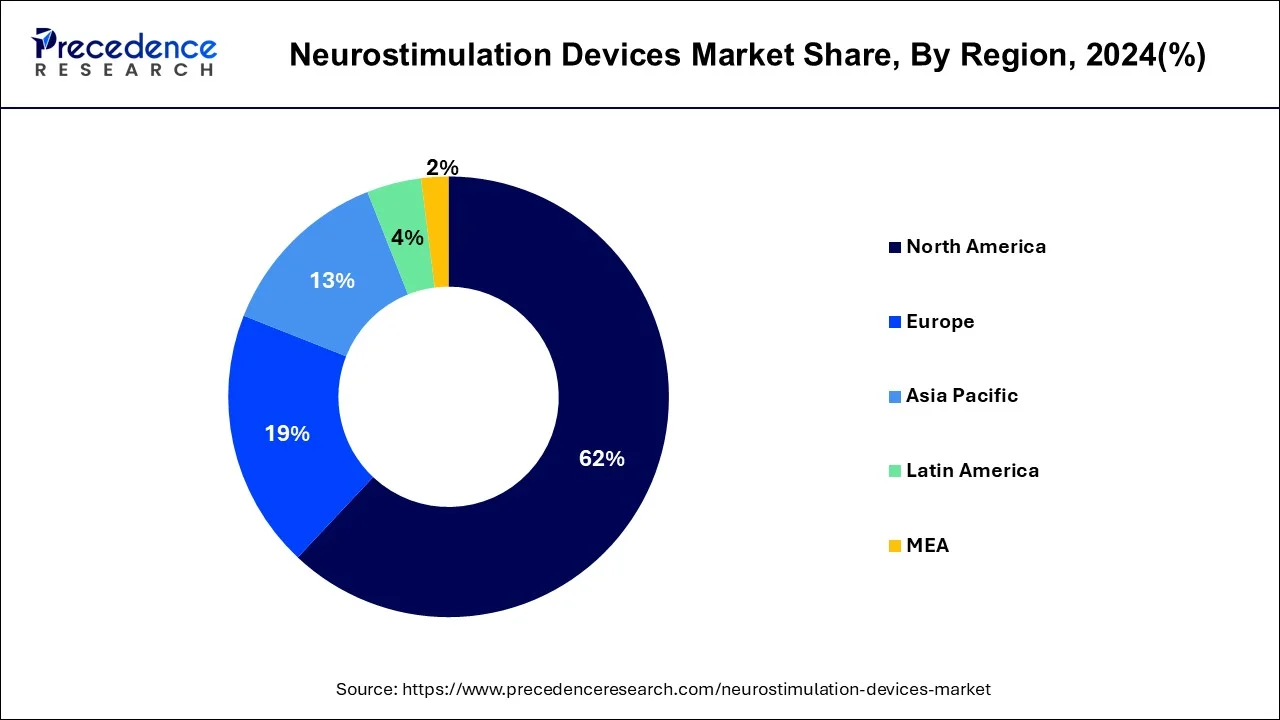List of Contents
Neurostimulation Devices MarketSize and Forecast 2025 to 2034
The global neurostimulation devices market size accounted for USD 12.45 billion in 2024 and is expected to exceed around USD 37.30 billion by 2034, growing at a CAGR of 11.60% from 2025 to 2034. The market is experiencing rapid growth due to rising occurrence of neurological and psychiatric disorder, growing awareness among people, and advancements in Medtech.

Neurostimulation Devices Market Key Takeaways
- North America garnered a market share of around 61.3% in 2024.
- By disease pathology, the cerebral aneurysm segment has held the largest market share in 2024.
- By products, the spinal cord segment captured the biggest revenue share in 2024.
- By application, the pain management segment registered the maximum market share in 2024.
U.S. Neurostimulation Devices MarketSize and Growth 2025 to 2034
The U.S. neurostimulation devices market size was exhibited at USD 5.38 billion in 2024 and is projected to be worth around USD 16.80 billion by 2034, growing at a CAGR of 12.06% from 2025 to 2034.

North America is supposed to be the biggest market during the conjecture time frame. The neurovascular gadgets market in North America is driven principally by elements, for example, the critical illness trouble, expanded number of negligibly obtrusive nervous system science strategies, and proceeded with extension of injury/crisis care offices in US. The severe unofficial laws and an ascent in the normal number of days expected in the FDA endorsement cycle might hamper the district's development. Europe followed North America, as far as income share. Quick financial improvement in Eastern European nations is supposed to speed up this development further. Besides, since getting a CE endorsement is simpler than getting an FDA endorsement, the creation entrance is moderately higher around here.
The U.S. holds the largest share in the market due to increasing need of treatments for neurological conditions such as chronic pain, epilepsy, Parkinson's disease, and depression. Another important driving factor is the continuous innovation in neurostimulation devices such as improved precision, closed-loop systems, and new stimulation paradigms which is further expanding the range of conditions that can be managed with these therapies. The U.S. based companies such as Medtronic, Abbott, and Boston Scientific are the major players which operate globally further contributing in neurostimulation devices exports. The U.S is a significant exporter of these devices with the export destinations including Netherlands, China, Germany, Japan, Canada, the UK, and South Korea. Additionally, the U.S. exports to countries in Europe, Asia-Pacific, Latin America, and the Middle East and Africa.
Canadian market is experiencing a notable growth due to the increasing awareness and acceptance about such neurological disorder among people is also driving the market where multiple key organizations frequently run awareness campaigns. Canada does export medical devices including neurostimulation devices to the major destinations such as the U.S., Netherlands, China, Japan, Australia, the UK, France, Ireland, Italy, Germany, and Singapore.

In addition, the developing geriatric populace in the locale is probably going to help the market development. Then again, Asia Pacific is supposed to be the quickest developing local market from 2025 to 2034. This development can be ascribed to the way that few global makers are moving their creation bases around here because of the presence of neglected clinical requirements and undiscovered learning experiences. Moreover, the fast financial advancement in arising nations, like India and China, and rising medical care consumptions are assessed to help the market improvement in the APAC locale.
China is experiencing rapid growth in neurostimulation devices market due to neurological disorders caused by population aging, socioeconomic development disparities, and the rise of chronic diseases. This leads to the increasing utilization of medical devices to treat these neurological conditions. Developments in Medtech of this region enable healthcare sector to rely on medical devices for diagnosis and treatments. Products such as spinal cord stimulators, deep brain stimulators, sacral nerve stimulators, vagus nerve stimulators, and gastric electric stimulators are critical to the market. China is a major global exporter of medical devices, including neurostimulation devices, and they are a significant player in the global market for these devices. The export destinations include many countries in Asia, Europe, and South America along with the United States, and Canada.
Neurostimulation Devices Market Growth Factors
Neurostimulation is a cycle that utilizes an implantable clinical gadget to balance and modify brain exercises for restorative purposes. Hardware utilized for neuromodulation are called neurostimulators and the cycle is named neurostimulation.
A portion of the key factors driving the market incorporate the developing geriatric populace, the presentation of mechanically progressed items, heightening item interest as extra treatment, a rising rate of ongoing illnesses, like headache and epilepsy, and the presence of exceptionally neglected clinical requirements in these sickness sections. Likewise, the rising predominance of neurological problems and way of life related messes, outer subsidizing for R&D, and interest for insignificantly intrusive medical procedures are different elements impelling the market development. As per the American Academy of Neurology, stroke is positioned as the third-driving reason for death in the U.S., with Alzheimer's being positioned as the 6th driving reason for death.
Neurological problems like Alzheimer's illness, Parkinson's infection, epilepsy, and cerebrovascular sicknesses influence the focal sensory system (CNS) and fringe sensory system (PNS) of the human body. To deal with these neurological issues, neurostimulation procedure assumes an essential part. The anodes in the gadgets produce gentle electrical motivations to enhance the neurological exercises in the patients. These gadgets are can be embedded or can be outside. Neurostimulation gadgets are straightforwardly positioned inside the cerebrum, PNS or CNS. Spinal cord triggers, profound cerebrum triggers, sacral nerve triggers, and vagus nerve triggers are a portion of the neurostimulation gadgets utilized in treating patients with different sicknesses like torment the executives, hearing misfortune, urinary incontinence, Parkinson's illness, and epilepsy.
Roughly 48 million individuals are impacted in America and almost 360 million individuals around the world, as per the information distributed by the Hearing Health Foundation in 2020. Moreover, according to the information distributed by the Epilepsy Center, by and by, around 50 million patients are living with epilepsy overall and around 2.4 million new cases are analyzed yearly. In addition, larger part of the epileptic cases is idiopathic, with no recognizable reason. Likewise, as indicated by the U.S. Habitats for Disease Control and Prevention's National Center for Health Statistics, in 2014, around half of more seasoned Americans experienced urinary or gut spillage; around 25% had moderate to serious urinary spillage, and around 8% had moderate to extreme gut spillage. According to the information distributed by WHO, in 2017, the predominance of urinary incontinence goes from 9.9% to 36.1% (detailed in populace based examinations). These expansion in occurrences and ascend in commonness of neurological problems are supposed to fuel the development of the market.
The factors, for example, ascend in commonness of way of life illnesses like sorrow and ongoing torment, expansion in number of neurological problems, and speculation for neurological R&D drive the development of the worldwide neurostimulation gadgets market. In addition, ascend sought after for negligible obtrusive medical procedure, reception of mechanically progressed items, and flood in maturing populace likewise move the development of the market as they are more powerless to neurological issues, like Epilepsy, Parkinson's sickness, Alzheimer's illness, and persistent agony. Notwithstanding, secondary effects, for example, unfavorably susceptible response and shivering or prickling of the skin because of implantation of neurostimulation gadget into the body and expansion in cost of gadgets are supposed to limit the development of the market. Moreover, accessibility of other treatment choices, for example, drug treatments and medical procedures limit the market development. Going against the norm, research in regards to the utilization of neurostimulators for overseeing sicknesses like fanatical urgent problems, interstitial cystitis, and asthma are continuous and are supposed to set out rewarding open doors for the development of the neurostimulation gadgets market before very long.
Insights from a similar source demonstrate that Parkinson's influences almost 1 million Americans with no less than 60,000 new cases that are accounted for yearly. In this manner, with the rising instances of neurological sicknesses, the interest for neurostimulation gadgets is supposed to not long from now develop. In addition, makers are putting more in R&D for the improvement of cutting edge items and advances, for example, implantable neurostimulation gadgets, as most would consider being normal to support the market development. Neurostimulation gadget implantation is a negligibly intrusive interaction and the rising interest for such medical procedures, because of more limited emergency clinic stays and quicker recuperation, is supposed to offer new learning experiences for the market.
Market Scope
| Report Coverage | Details |
| Market Size in 2025 | USD 13.92Billion |
| Market Size by 2034 | USD 37.30 Billion |
| Growth Rate from 2025 to 2034 | CAGR of 11.60% |
| Base Year | 2024 |
| Forecast Period | 2025 to 2034 |
| Segments Covered | Technology, Disease Pathology, Product, Application, and End Users |
| Regions Covered | North America, Europe, Asia-Pacific, Latin America, and Middle East & Africa |
Technology Insights
The aneurysm snaking and embolization gadgets portion is normal record for the biggest portion of the neurovascular gadgets market during the conjecture time frame. In 2023, attributable to developing end-client inclination for negligibly obtrusive neurosurgical methods and expanding market accessibility of embolic loops for neurovascular treatment.
Disease Pathology Insights
The cerebral aneurysm fragment is assessed to represent the biggest portion of the worldwide interventional nervous system science market during the estimate time frame. The cerebral aneurysm portion is assessed to represent the biggest portion of the worldwide interventional nervous system science market, by pathology, in 2023, drove by the developing reception of negligibly obtrusive neurosurgical methodology among neurosurgeons, expanding medical care use in arising nations, and expanding occurrence of hazard factors, (for example, hypertension, cigarette smoking, elevated cholesterol, diabetes, and stoutness).
Products Insights
The spinal cord trigger segment dominated the market in 2023. Mechanical headways in this section are supposed to drive the portion further. Spinal cord triggers are utilized in non-harmful constant neuropathic torment the executives as they assist with concealing the agony by delivering little nerve driving forces without rolling out any physical improvements to the objective region.
Deep cerebrum triggers are utilized in the treatment of a few neurological issues, particularly Parkinson's illness. These gadgets depend on a beginning innovation and hence are presently going through an exploratory stage. The utilization of these gadgets for infections, like Alzheimer's, Tourette condition, headstrong epilepsy, group cerebral pain, trigeminal neuralgia, and development problems by different sclerosis, is anticipating FDA endorsement. Sacral nerve triggers, utilized in the therapy of ongoing sicknesses including urinary incontinence and waste incontinence, are supposed to witness the quickest CAGR from 2024 to 2033. Expanding mindfulness in regards to these gadgets is supposed to be the significant driving variable for this portion. In any case, different dangers related with the implantation of these gadgets, for example, mechanical disappointments and post-medical procedure torments and diseases, may thwart the section development somewhat.
Application Insights
The pain management segment accounted largest market share in 2023. The high predominance of constant torment issues and developing item use for torment the board by virtue of its high restorative worth are the key elements driving the development of this fragment. The portion is supposed to enlist the quickest CAGR also over the estimate period. A portion of the infections enveloped under this fragment incorporate ongoing torment, plate a medical procedure torment, and leg torment.
Epilepsy is a seizure-causing neurological confusion and influences roughly 50 million individuals across the globe, as indicated by the World Health Organization (WHO). The high item viability showed in treating epilepsy combined with the accessibility of restricted treatment choices for the illness is supposed to prompt the fragment development during the forecast period. Fundamental quakes are portrayed by extreme compulsory appendage development. The infection likewise influences the neck, jaw, and other body parts. The developing geriatric populace across the globe is one of the greatest effect delivering drivers for the development of this portion. The rising instances of melancholy are likewise prone to add to the market improvement as neurostimulation hardware gives simple treatment by initiating or hindering electrical brain signals.
End User Insights
In light of end-client, the neurovascular gadgets market has been sectioned into emergency clinics and careful focuses, mobile consideration places, and examination labs, and scholastic establishments. Starting around 2020, emergency clinics and careful focuses are assessed to represent the biggest portion of the worldwide market in 2023, while wandering consideration places are projected to enroll the most noteworthy CAGR during the forecast period. Developing patient inclination for negligibly obtrusive operations, rising number of wandering a medical procedure community across created nations, alongside the simplicity of planning, the engaged clinical staff, the better efficiency, and the expanded security, and viability of these focuses, are the main considerations that are supposed to drive the development of this end-client fragment before long.
Neurostimulation Devices Market Companies
- Medtronic PLC
- Cyberonics
- Boston Scientific Corp.
- St. Jude Medical, Inc.
- Nevro Corp.
- MicroPort Scientific Corporation (China),
- Kaneka Corp. (Japan)
- Integer Holdings Corporation
- BALT (France)
- Perflow Medical
- Phenox GmbH (Germany)
- Sensome (France)
Latest Updates on Neurostimulation Devices Market in 2025
Adaptive Neurostimulation Technology
It adjusts stimulation parameters in real-time based on a patient's individual needs and responses. This is achieved by monitoring brain signals, body position, or other relevant feedback and dynamically altering the stimulation settings. This personalized approach aims to optimize therapeutic benefits, reduce side effects, and improve patient comfort. By adjusting stimulation parameters, adaptive system can minimize side effects to avoid overstimulation or other undesirable responses. aDBS is being used to treat a range of conditions such as movement disorders, pain, and cognitive and psychiatric disorders.
Closed-loop neurostimulation systems
These are advanced therapeutic devices that dynamically adjust stimulation parameters based on real-time physiological or neurological feedback. Open-loop devices deliver pre-programmed stimulation whereas closed-loop systems adapt their output to optimize effectiveness, improve clinical outcomes, and potentially reduce side effects. The system continuously monitors neural activity or other relevant biomarkers and adjusts stimulation parameters such as intensity, frequency, pulse duration to match the detected physiological state.
Recent Developments
- In April 2025, Houston-based Nexalin Technology launched a new clinical trial for anxiety and chronic insomnia treating device, Gen-2 15-milliamp neurostimulation device. The Nexalin's Gen-2 15-milliamp neurostimulation devices were shipped to São Paulo, Brazil to conduct study at the Instituto de Psiquiatria university hospital. The shipments aim to support the launch of a Phase II clinical trial in adult patients suffering from anxiety and insomnia. (Source: https://houston.innovationmap.com)
- In February 2025, Medtronic plc, a global leader in healthcare technology announced U.S. Food and Drug Administration (FDA) approval of BrainSense Adaptive deep brain stimulation (aDBS) and BrainSense Electrode Identifier (EI). ( Source:https://news.medtronic.com)
- In December 2024, Medtronic launched neurostimulator for movement disorders such as Parkinson's and epilepsy in India. ( Source:https://www.financialexpress.com)
Segments Covered in the Report
By Technology
- Aneurysm coiling & embolization devices
- Bare detachable coils
- Coated detachable coils
- Embolic coils
- Flow diversion devices
- Liquid embolic agents
- Cerebral balloon angioplasty & Stenting systems
- Carotid artery stents
- Embolic protection devices
- Balloon catheters
- Support devices
- Microcatheters
- Guidewires
- Neurothrombectomy devices
- Clot retrievals
- Suction & aspiration devices
- Snares
By Disease Pathology
- Ischemic Strokes
- Cerebral Aneuryms
- Carotid Artery Stenosis
- Arteriovenous Malformations and Fistulas
- Other Diseases
By Product
- Spinal Cord Stimulator
- Deep Brain Stimulator
- Sacral Nerve Stimulator
- Vagus Nerve Stimulator
- Gastric Electric Stimulator
By Application
- Pain Management
- Epilepsy
- Essential Tremor
- Urinary and Fecal Incontinence
- Depression
- Dystonia
- Gastroparesis
- Parkinson's Disease
- Others
By End Users
- Hospitals & Surgical Centers
- Ambulatory Care Centers
- Research Laboratories & Academic Institutes
By Geography
- North America
- U.S.
- Canada
- Europe
- U.K.
- Germany
- France
- Asia-Pacific
- China
- India
- Japan
- South Korea
- Malaysia
- Philippines
- Latin America
- Brazil
- Rest of Latin America
- Middle East & Africa (MEA)
- GCC
- North Africa
- South Africa
- Rest of the Middle East & Africa
For inquiries regarding discounts, bulk purchases, or customization requests, please contact us at sales@precedenceresearch.com
Frequently Asked Questions
Ask For Sample
No cookie-cutter, only authentic analysis – take the 1st step to become a Precedence Research client